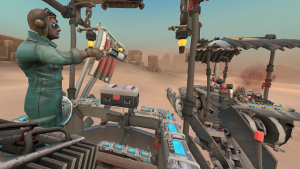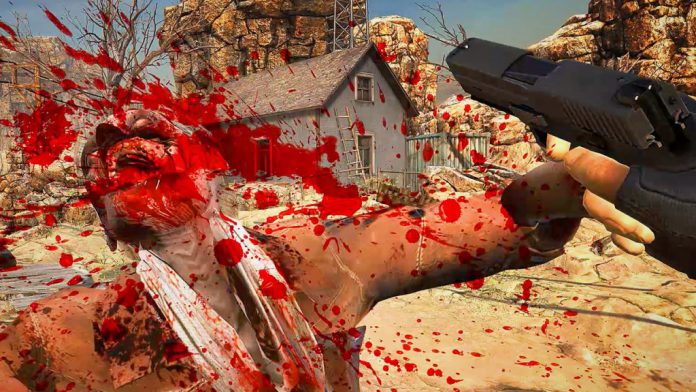Still remaining one of the most popular genres in videogames today, the first-person shooter (FPS) is often considered the holy grail of virtual reality (VR) gaming. The natural assumption by many that the first-person shooting gameplay would adapt to this new medium has been proven flawed for more than two years now, but that’s not to say it won’t ever happen. In fact, considerable progress towards reaching this goal has already been made.
One of the first FPS experiences to be considered a highlight of modern VR was Survios’ Zombies on the Holodeck. While it was undoubtedly entertaining in short doses, played on the now primitive Oculus Rift development kit (aka DK1) it suffered the same issues as Valve’s Half-Life 2 and Team Fortress 2 adaptations: that is, it could quite quickly make the player feel nauseas. Simulator sickness is one of the biggest issues when designing FPS experiences, though some developers have come-up with techniques to combat this.
Vertigo Games’ Arizona Sunshine is essentially an arcade light-gun style experience that gives the player space to move. Motion is tracked via the HMD and controllers in a limited space (potentially less so with the HTC Vive opposed to the Oculus Rift and PlayStation VR, though further testing has to be conducted for a greater understanding of the latter two’s limitations). The player starts each wave in a set location and takes down the zombies encroaching on their position before teleporting to the next location.
Teleportation is used commonly in VR at present and Epic Games’ technical demonstration for the Oculus Rift, the highly acclaimed Bullet Train, does so to admirable effect. Like Arizona Sunshine, the player has only a limited space in which to move, however the teleportation here is manual and can be conducted at any time. It’s not long before the player is able to dart back-and-forth between the series of teleportation points scattered around the train station in which Bullet Train is set.
The HTC Vive launch title Hover Junkers takes things in a different direction, with the player grounded by the fact that they are actually upon a moving vehicle. The vehicle can be controlled manually before the player moves to the rear end of the craft to engage in combat. Though some players still report occurrences of simulator sickness with Hover Junkers’ demands of rapid movement in order to compete, the likelihood of such issues are significantly lessened given that the player isn’t being forced to move unnaturally, but rather the vehicle upon which they stand.

The upcoming HordeZ – again, for HTC Vive – uses a similar technique. The player is positioned on a hovering platform which moves automatically while the player takes aim on their zombie foes. It’s a simple but effective technique, as the player never once feels like they should be moving; they just are.
Survios’ latest project however, Raw Data, ignores the lessons learned here altogether by simply giving the two-players in the co-operative experience a very small space to move around in. Dictated by the HTC Vive’s tracking limitations (though oddly with in-game furniture placed within this space), Raw Data is a shooting gallery similar to Arizona Sunshine. It’s an interesting but malnourished experience, with many other titles featured in this article outranking it as a potential highlight for shooting gameplay within VR.
So what does the future hold for FPS in VR? There’s no doubt in VRFocus’ collective mind that someone will find the solution in time. Significant steps have been made in such a short period that it’s highly likely a developer will have discovered the secret of delivering direct locomotion control in VR by the time this new medium hits the mainstream. As always, you can be sure VRFocus will keep you informed of all the latest advancements along the way.















